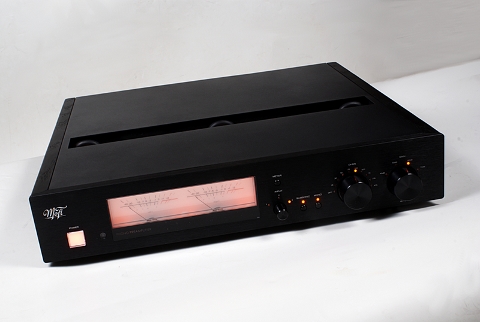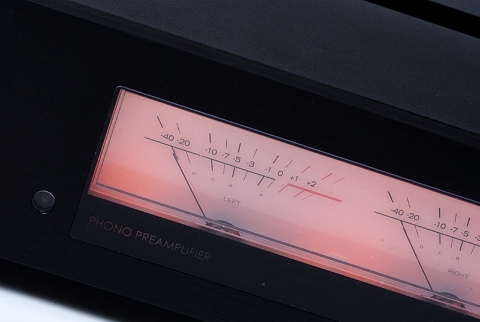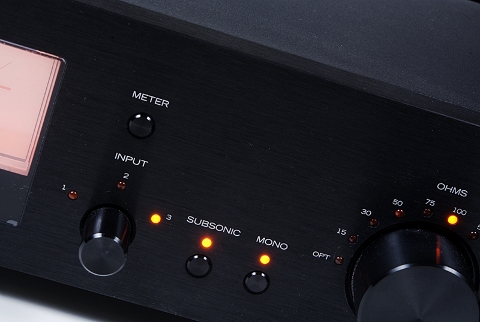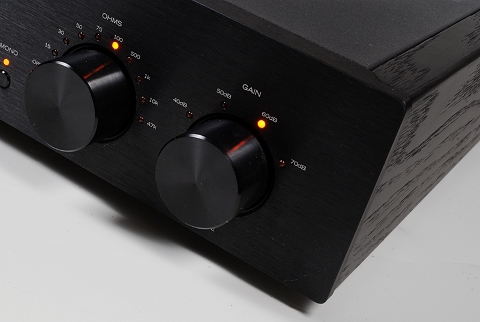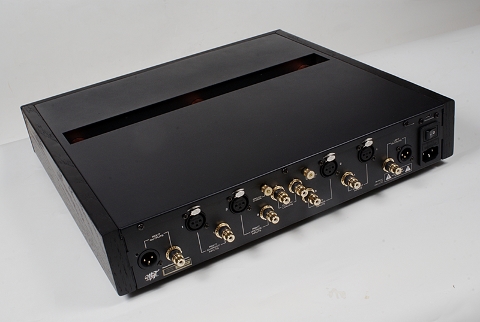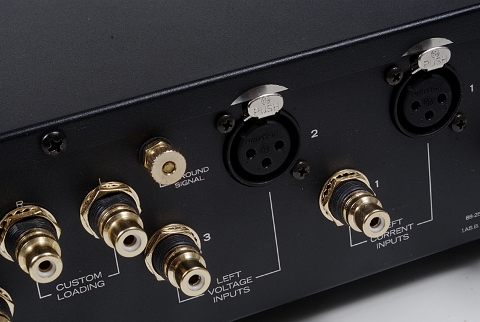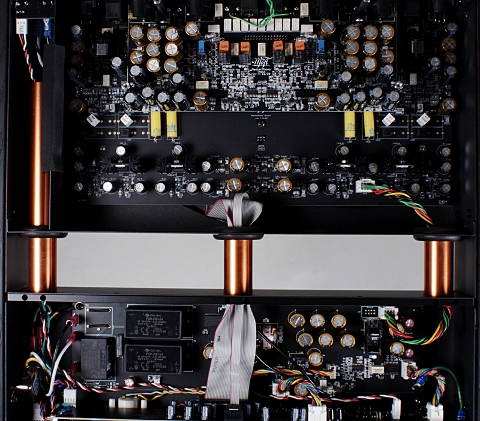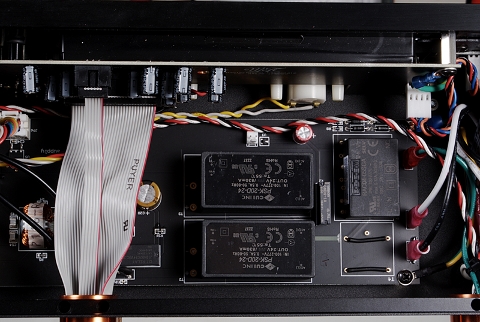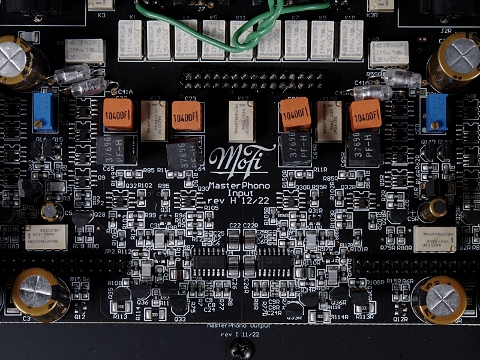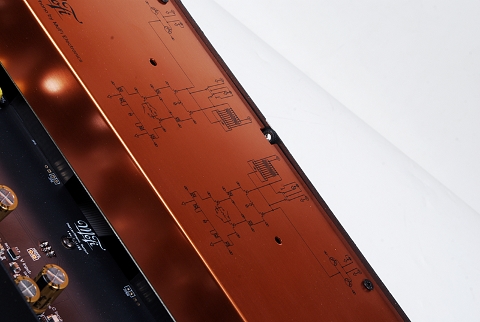about Audio, High Fidelity
& Home Entertainment technologies
pid: 607-2025/10/01 (v1.2)
Privacy Policy
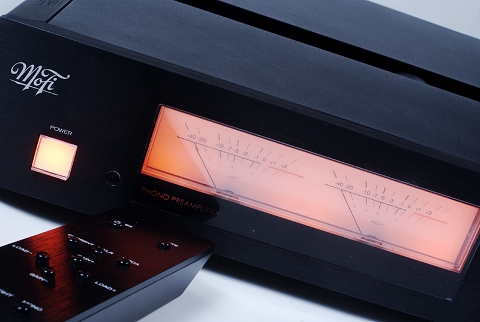
The first thing that grabs everyone's attention when they see the MasterPhono is, without a doubt, those big level meters on the front panel. They light up brightly and take up almost half of the front. The second thing that stands out is its unusual chassis design—it looks like it’s split in half, with the two sections connected by three metal cylinders. What seems to hold everything together are the wooden side panels. A simple but cool idea!
The MasterPhono is visually impressive. It’s not just the level meters that draw attention but also the dual-chassis design.
In reality, the MasterPhono consists of two separate chassis: the front section, which houses the power supply, meters, control circuits, and user interface, and the rear section, which contains the audio signal circuits and connection terminals. This isn’t an unusual design approach, but instead of having two separate units connected by external cables, MoFi integrated everything into a single unit. The electrical connections pass through three copper-plated conduits (probably for aesthetic reasons). Each conduit has a specific purpose—one carries high-voltage power cables, another handles control signals, and the third transfers DC power.
Beyond aesthetics, the meters are useful if you take advantage of them. Aside from proper gain adjustment, MoFi has incorporated additional functionality!
The user interface is clear and well-designed, with switches that feel solid. The input impedance selector offers plenty of options in real-time (and the remote control allows adjustments from your listening position).
Inside, the chassis is compartmentalized with metal plates, and the input stage is fully shielded. It uses FET transistors, and the entire circuit is built with discrete components. The RIAA equalization is passive, meaning the three-time constants are implemented with RC networks between two gain stages.
The MasterPhono gives users three independent inputs, each with fully adjustable gain and cartridge loading settings, stored in the unit’s microcontroller. Two of these are standard—a single-ended RCA input (which will be the go-to for most setups) and a balanced XLR input for tonearms wired for true balanced operation.
The third input, however, is something special—it supports transimpedance mode. Confused? That's fair because these designs are pretty rare. A transimpedance amplifier converts current into voltage, meaning it operates based on the current generated by the cartridge rather than its voltage output. This type of connection is ideal for cartridges with very low internal resistance (around 10 Ohm or less). For example, the Denon DL-103R (14Ω) and the Audio-Technica AT33 PTG/II (10Ω) are great candidates for this type of connection. And just a heads-up—don't try to measure your cartridge's resistance with a multimeter, as you might damage the coil!
The MasterPhono does not have a dedicated MM/MC switch; instead, gain is adjustable in four steps. Combined with input impedance settings, it can accommodate most cartridges. For more demanding setups, custom loading options are available.
Connectivity is excellent, offering single-ended and balanced inputs and outputs, with three input options in total…
Transimpedance phono stages have been discussed for years as a way to eliminate the need for precise cartridge loading. Instead, they force the cartridge to drive a near-short circuit, essentially making it act as a current source. One advantage of this approach is potentially lower noise from external interference, thanks to the low-impedance connection. Additionally, since the signal is carried as current variations, it may reduce distortion from the cartridge’s magnetic system. Having this input on the MasterPhono means you can experiment and hear the difference for yourself.
For the other two inputs, users can choose from nine different loading values, ranging from 15Ω to 47kΩ, plus a custom setting that allows for resistors to be inserted via RCA plugs. Gain can be set in four steps: 40dB, 50dB, 60dB, and 70dB. There’s also a mono switch (for mono records) and a subsonic filter. While the unit doesn’t offer a selectable capacitance setting, the default is 150pF, and if needed, you can use the custom load feature to fine-tune it.
…one of which is a Current Injection input. The “Custom Loading” terminals allow for the installation of resistors required for proper cartridge loading. The selection is made from the front panel.
A clever idea if you want to isolate the circuit's structural components without resorting to separate chassis. There are distinct paths for high-voltage, control, and low-voltage power supply.
On the output side, the MasterPhono can connect to the rest of your system via either single-ended or balanced outputs. It also includes a remote control, which is a game-changer—it lets you adjust loading settings from your listening position, making A/B comparisons much easier. Another nice touch is the dual grounding system, with separate terminals for the motor/plinth ground and the signal ground. If your turntable has two ground connections, you’ll use both; if it only has one, you can experiment to see which gives the best results.
Now, back to those eye-catching meters! They have two obvious uses and one hidden trick. First, they just look cool—watching them bounce along with the music is a vibe. If that's not your thing, you can turn them off. Second, they help monitor the output levels, so you can make sure your gain settings are correct. Ideally, the needles should hover around 0dB with occasional peaks at +2 or +3dB. If they're constantly maxing out, you've got too much gain and overload can occur; if they barely move, you need more gain, because the noise could be higher than the best your system can offer.
And now, for the secret feature: Peter Madnick added a clever function that lets you use the meters to adjust cartridge azimuth! With a test record and a bit of calibration, you can measure the channel difference in “azimuth mode” and tweak it for optimal alignment. Pretty smart, right? And since the MasterPhono has a USB port for firmware updates, there’s potential for even more cool features down the line.
MoFi has opted for ready-made power supply modules from CUI. These provide a 24V output (leaving room for regulation, which is handled by 317/337). Perhaps, in this area, a more refined solution would be beneficial.
A compact and well-built circuit featuring discrete components and a quad op-amp per channel. The first stage is FET-based
Previous | Next | More Reviews

